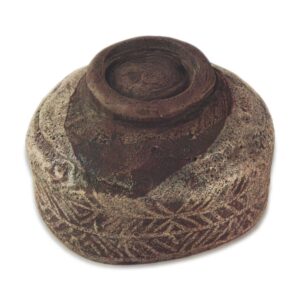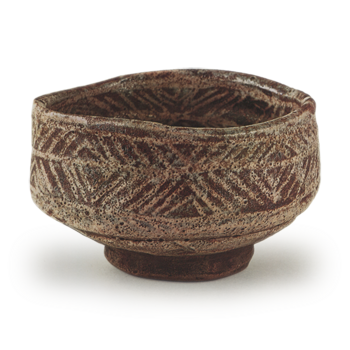

Height: 7.7 – 8.7 cm
Diameter: 13.2 – 13.5 cm
Outer diameter of foot ring: 7.0 cm
Height of foot ring: 1.0 cm
Like the “Ripples”, this tea bowl is thought to have been produced at the Takane Higashi Kiln.
There are three kiln sites at Takane, and the kiln one to the west is the one that produced the famous Akashino and Ishitsubaki gong bowls. No other kiln sites have produced Akashino with such good coloring. In contrast, the kiln to the east, which is joined to the other, is a strange kiln, and both very good works and boring ones are excavated at the same time. Many well-kneaded and well-made works are produced, and there are also works that could be mistaken for Mino Karatsu or rare works with Shino and Iwabane. The Fujita Museum’s “Choyo” may also have been made in this kiln. It is thought that someone, perhaps a teacher, must have been involved.
Nezumi Shino ware is made by applying a white slip made from natural iron oxide to the white clay body, and then applying Shino glaze. The color of the glaze and the thickness of the slip applied to the clay body, as well as the kiln used, can all affect the final color, which can range from a light grey to a reddish brown. After the pattern is scraped off after being decorated with the demon plate, and then Shino glaze is applied, the scraped-off areas look like they have been inlaid with white.
This tea bowl also has a hinoki fence pattern, with three rows on the outside and four rows on the inside. This is clearly modeled on the carved Mishima tea bowls of the Koryo tea bowls.
Generally, carved Mishima tea bowls are thought to be relatively late examples of Koryo tea bowls, but what about issues such as their production dates? It is interesting that, even though they are modeled on carved Mishima tea bowls, they still have their own unique Shino form.
Shino tea bowls are different in nature from those that were selected by tea masters from among the many that were made, such as Koryo tea bowls. The shapes and patterns were created after careful consideration.
Some are made entirely on the potter’s wheel, while others are made by hand, with only the waterline being made on the potter’s wheel and the rest being finished by hand. The way the foot ring is scraped inside and out, and the way the spatula is used from the foot ring to the waist, gives this tea bowl a solid, handmade appearance, and gives it the strong, distinctive shape of Shino ware. The coloration also shows subtle changes in color, with the grayish color of the iron casting standing out. The name “Tsūten” is probably derived from the interplay of this deep red color and the hinoki-bamboo pattern, which is reminiscent of the famous autumnal colors of the Tōfuku-ji temple’s Tsūtenkyō bridge.
The word “Tsūten” is written in gold powder on the inside of the box lid. The author and the history of the piece are unknown.



